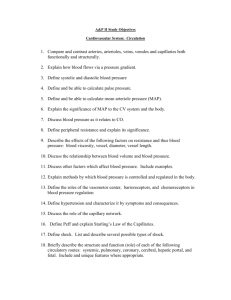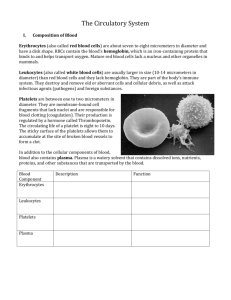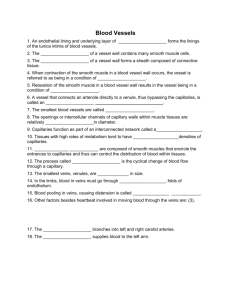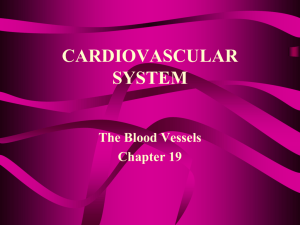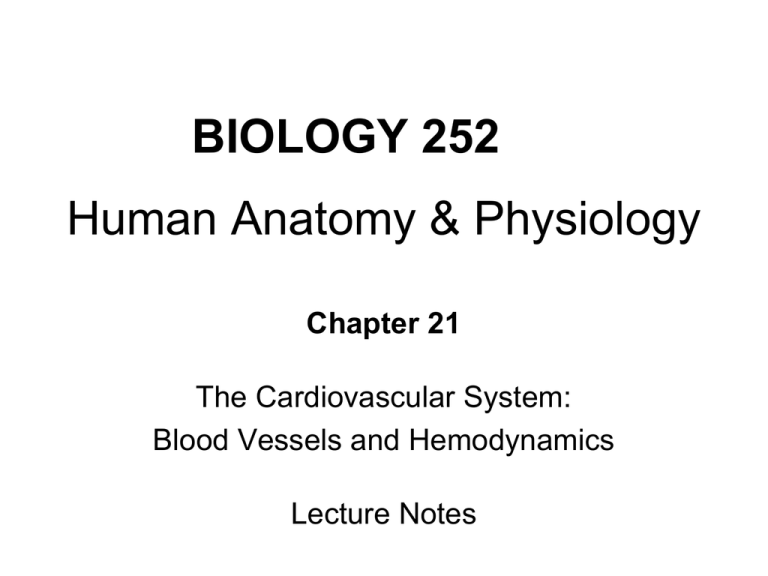
BIOLOGY 252
Human Anatomy & Physiology
Chapter 21
The Cardiovascular System:
Blood Vessels and Hemodynamics
Lecture Notes
The Cardiovascular System:
Blood Vessels and Hemodynamics
• Structure and function of
blood vessels
• Hemodynamics
– forces involved in
circulating blood
Anatomy of Blood Vessels
• Closed system of tubes that carries blood
• Arteries carry blood from heart to tissues
– Conducting arteries (elastic, large)
– Distributing arteries (muscular, medium)
– Resistance arteries ( the smallest = arterioles)
• Capillaries are thin enough to allow exchange of gases, nutrients
and waste products
• Venules merge to form veins that bring blood back to the heart
Arteries- cross reference with lab manual p. 2.2 & 2.3
• Tunica interna (intima)
– simple squamous epithelium
known as endothelium
– basement membrane
– internal elastic lamina
(lamina – thin plate or flat layer)
• Tunica media
– circular smooth muscle &
elastic fibers
– external elastic lamina
• Tunica externa
– elastic & collagen fibers
Structure
• Tunica interna (intima)
– Inner lining in direct contact with blood
– Endothelium continuous with endocardial lining of heart
– Active role in vessel-related activities
• Tunica media
– Muscular and connective tissue layer
– Greatest variation among vessel types
– Smooth muscle regulates diameter of lumen
• Tunica externa
– Elastic and collagen fibers
– Vaso vasorum – small vessels which supply the vessel itself.
– Helps anchor vessel to surrounding tissue
Sympathetic Innervation
• Vascular smooth muscle is innervated by
sympathetic nervous system only
– increase in stimulation causes muscle contraction or
vasoconstriction
• decreases diameter of vessel
– injury to artery or arteriole causes muscle contraction
reducing blood loss (vasospasm)
– decrease in stimulation or presence of certain chemicals
causes vasodilation
• increases diameter of vessel
• nitric oxide, K+, H+ and lactic acid cause vasodilation
Conducting - Elastic Arteries
• Largest-diameter arteries have a lot of elastic fibers
in tunica media
• Help propel blood onward despite ventricular
relaxation (stretch and recoil - pressure reservoir)
Distributing - Muscular Arteries
• Medium-sized arteries with more muscle than
elastic fibers in tunica media
• Capable of greater vasoconstriction and
vasodilation to adjust rate of flow
– walls are relatively thick
– called distributing arteries because they direct blood
flow
Resistance Arteries - Arterioles
• Small arteries delivering
blood to capillaries
– tunica media containing few
layers of muscle
• Metarterioles form branches
into capillary bed
– to bypass capillary bed,
precapillary sphincters close &
blood flows out of bed in
thoroughfare channel
Capillaries
Copyright © 2015 John Wiley &
Sons, Inc. All rights reserved.
Capillaries form Microcirculation
• Microscopic vessels that connect arterioles to venules
• Found near every cell in the body but more extensive in highly active
tissue (muscles, liver, kidneys & brain)
– entire capillary bed fills with blood when tissue is active
• Function is exchange of nutrients & wastes between blood and tissue
fluid
• Structure is single layer of simple squamous epithelium and its
basement membrane
•
Types: continuous (CNS, lungs, muscle tissue, skin); fenestrated (kidneys,
brain, eyes, most endocrine glands); sinusoids (spleen, anterior pituitary,
parathyroid and adrenal glands)
Types of Capillaries
Continuous capillaries
Copyright © 2014 John Wiley & Sons, Inc. All rights reserved.
Types of Capillaries
Fenestrated capillaries
Copyright © 2014 John Wiley & Sons, Inc. All rights reserved.
Types of Capillaries
Sinusoid capillaries
Copyright © 2014 John Wiley & Sons, Inc. All rights reserved.
Venules
• Small veins collecting blood from capillaries
• Tunica media contains only a few smooth
muscle cells
– very porous endothelium allows for escape of
many phagocytic white blood cells
• Venules that approach size of veins more
closely resemble structure of vein
Veins
• Proportionally thinner walls than same diameter
artery
– tunica media less muscle
– lack external & internal
elastic lamina
• Still adaptable to variations
in volume & pressure
• Valves are thin folds of
tunica interna designed
to prevent backflow
Hemodynamics
• Factors affecting circulation
– pressure differences that drive the blood flow
• velocity of blood flow
• volume of blood flow
• blood pressure
– resistance to flow
– venous return
• An interplay of forces result in blood flow
Poiseuille’s Law
(pwah-SWEEZ)
• Volume of blood flow =
Pressure gradient ÷ resistance
Volume of Blood flow =
Pressure x (vessel radius)4
Vessel length x Viscosity
You do not need to memorize the equations – what is important is the
fact that small changes in vessel radius have a significant affect on
volume of flow because of the radius being raised to the 4th power. Eg.
If vessel radius were to double then the volume of blood flowing
through that vessel would be 16 times greater – 2 x 2 x 2 x 2 = 16.
Velocity of Blood Flow
• Speed of blood flow in cm/sec is inversely related to
cross-sectional area
– blood flow is slower in the
arterial branches
• flow in aorta is 40 cm/sec while
flow in capillaries is .1 cm/sec
• slow rate in capillaries allows for
exchange
• Blood flow becomes faster
when vessels merge to form veins
• Circulation time is time it takes a drop of blood to
travel from right atrium back to right atrium
Volume of Blood Flow
• Cardiac output = stroke volume x heart rate
• Other factors that influence blood flow
– blood pressure
• blood flows from areas of higher pressure to areas of lower
pressure
– resistance due to friction between blood cells and
blood vessel walls
Blood Pressure
• Pressure exerted by blood by walls of a vessel
– caused by contraction of the ventricles
– highest in aorta
• 120 mm Hg during systole & 80
during diastole
• If heart rate increases cardiac
output, BP rises
• Pressure falls steadily in
systemic circulation with
distance from left ventricle
– 35 mm Hg entering the capillaries
– 0 mm Hg entering the right atrium
• If decrease in blood volume is over 10%, BP drops
• Water retention increases blood pressure
Resistance
• Friction between blood and the walls of vessels
– average blood vessel radius
• smaller vessels offer more resistance to blood flow
– blood viscosity (thickness)
• ratio of red blood cells to plasma volume
• increases in viscosity increase resistance
– dehydration or polycythemia
– total blood vessel length
• the longer the vessel, the greater the resistance to flow
• An estimated 650 meters of blood vessels develop for every
extra kilogram of fat
– obesity causes high blood pressure
• Systemic vascular resistance is the total of above
– arterioles control BP by changing diameter
Venous Return
• Volume of blood flowing back to the heart from the systemic
veins
– depends on pressure difference from venules (16 mm Hg) to right
atrium (0 mm Hg)
• Skeletal muscle pump
– contraction of muscles &
presence of valves
• Respiratory pump
– decreased thoracic pressure
and increased abdominal
pressure during inhalation,
moves blood into thoracic veins and the right atrium
Syncope
• Fainting or a sudden, temporary loss of
consciousness not due to trauma
– due to cerebral ischemia or lack of blood flow to the brain
• Causes
– vasodepressor syncope = sudden emotional stress
– situational syncope = pressure stress of coughing,
defecation, or urination
– drug-induced syncope = antihypertensives, diuretics,
vasodilators and tranquilizers
– orthostatic hypotension = decrease in BP upon standing
Control of Blood Pressure & Flow
• Role of cardiovascular center
– help regulate heart rate & stroke volume
– specific neurons regulate blood vessel diameter
Input to the Cardiovascular Center
• Higher brain centers such as cerebral cortex,
limbic system & hypothalamus
– anticipation of competition
– increase in body temperature
• Proprioceptors
– input during physical activity
• Baroreceptors
– changes in pressure within blood vessels
• Chemoreceptors
– monitor concentration of chemicals in the blood
Output from the Cardiovascular Center
• Heart
– parasympathetic (vagus nerve)
• decrease heart rate
– sympathetic (cardiac accelerator nerves)
• cause increase or decrease in contractility & rate
• Blood vessels
– sympathetic vasomotor nerves
• continual stimulation to arterioles in skin & abdominal viscera
producing vasoconstriction (vasomotor tone)
• increased stimulation produces constriction & increased BP


